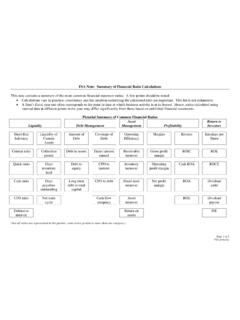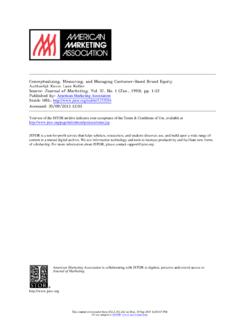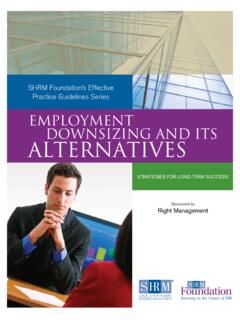Transcription of A STEP-BY-STEP GUIDE TO THE BLACK-LITTERMAN MODEL ...
1 A STEP-BY-STEP GUIDE TO THE BLACK-LITTERMAN MODEL Incorporating user-specified confidence levels Thomas M. Idzorek* Thomas M. Idzorek, CFA Senior Quantitative Researcher Zephyr Associates, Inc. PO Box 12368 312 Dorla Court, Ste. 204 Zephyr Cove, NV 89448 Ext. 241 Fax Original Draft: January 1, 2002 This Draft: July 20, 2004 This paper is not intended for redistribution. * Senior Quantitative Researcher, Zephyr Associates, Inc., PO Box 12368, 312 Dorla Court Ste. 204, Zephyr Cove, NV 89448, USA. Tel.: 1 775 588 0654; e-mail: A STEP-BY-STEP GUIDE TO THE BLACK-LITTERMAN MODEL Incorporating user-specified confidence levels ABSTRACT The BLACK-LITTERMAN MODEL enables investors to combine their unique views regarding the performance of various assets with the market equilibrium in a manner that results in intuitive, diversified portfolios.
2 This paper consolidates insights from the relatively few works on the MODEL and provides STEP-BY-STEP instructions that enable the reader to implement this complex MODEL . A new method for controlling the tilts and the final portfolio weights caused by views is introduced. The new method asserts that the magnitude of the tilts should be controlled by the user-specified confidence level based on an intuitive 0% to 100% confidence level. This is an intuitive technique for specifying one of most abstract mathematical parameters of the BLACK-LITTERMAN MODEL . A STEP-BY-STEP GUIDE TO THE BLACK-LITTERMAN MODEL 1 A STEP-BY-STEP GUIDE TO THE BLACK-LITTERMAN MODEL Incorporating user-specified confidence levels Having attempted to decipher many of the articles about the BLACK-LITTERMAN MODEL , none of the relatively few articles provide enough STEP-BY-STEP instructions for the average practitioner to derive the new vector of expected This article touches on the intuition of the BLACK-LITTERMAN MODEL , consolidate insights contained in the various works on the BLACK-LITTERMAN MODEL .
3 And focus on the details of actually combining market equilibrium expected returns with investor views to generate a new vector of expected returns. Finally, I make a new contribution to the MODEL by presenting a method for controlling the magnitude of the tilts caused by the views that is based on an intuitive 0% to 100% confidence level, which should broaden the usability of the MODEL beyond quantitative managers. Introduction The BLACK-LITTERMAN asset allocation MODEL , created by Fischer Black and Robert Litterman, is a sophisticated portfolio construction method that overcomes the problem of unintuitive, highly-concentrated portfolios, input-sensitivity, and estimation error maximization.
4 These three related and well-documented problems with mean-variance optimization are the most likely reasons that more practitioners do not use the Markowitz paradigm, in which return is maximized for a given level of risk. The BLACK-LITTERMAN MODEL uses a Bayesian approach to combine the subjective views of an investor regarding the expected returns of one or more assets with the market equilibrium vector of expected returns (the prior distribution) to form a new, mixed estimate of expected returns. The A STEP-BY-STEP GUIDE TO THE BLACK-LITTERMAN MODEL 2 resulting new vector of returns (the posterior distribution), leads to intuitive portfolios with sensible portfolio weights.
5 Unfortunately, the building of the required inputs is complex and has not been thoroughly explained in the literature. The BLACK-LITTERMAN asset allocation MODEL was introduced in Black and Litterman (1990), expanded in Black and Litterman (1991, 1992), and discussed in greater detail in Bevan and Winkelmann (1998), He and Litterman (1999), and Litterman (2003).2 The Black Litterman MODEL combines the CAPM (see Sharpe (1964)), reverse optimization (see Sharpe (1974)), mixed estimation (see Theil (1971, 1978)), the universal hedge ratio / Black s global CAPM (see Black (1989a, 1989b) and Litterman (2003)), and mean-variance optimization (see Markowitz (1952)).
6 Section 1 illustrates the sensitivity of mean-variance optimization and how reverse optimization mitigates this problem. Section 2 presents the BLACK-LITTERMAN MODEL and the process of building the required inputs. Section 3 develops an implied confidence framework for the views. This framework leads to a new, intuitive method for incorporating the level of confidence in investor views that helps investors control the magnitude of the tilts caused by views. 1 Expected Returns The BLACK-LITTERMAN MODEL creates stable, mean-variance efficient portfolios, based on an investor s unique insights, which overcome the problem of input-sensitivity.
7 According to Lee (2000), the BLACK-LITTERMAN MODEL also largely mitigates the problem of estimation error-maximization (see Michaud (1989)) by spreading the errors throughout the vector of expected returns. A STEP-BY-STEP GUIDE TO THE BLACK-LITTERMAN MODEL 3 The most important input in mean-variance optimization is the vector of expected returns; however, Best and Grauer (1991) demonstrate that a small increase in the expected return of one of the portfolio's assets can force half of the assets from the portfolio. In a search for a reasonable starting point for expected returns, Black and Litterman (1992), He and Litterman (1999), and Litterman (2003) explore several alternative forecasts: historical returns, equal mean returns for all assets, and risk-adjusted equal mean returns.
8 They demonstrate that these alternative forecasts lead to extreme portfolios when unconstrained, portfolios with large long and short positions; and, when subject to a long only constraint, portfolios that are concentrated in a relatively small number of assets. Reverse Optimization The BLACK-LITTERMAN MODEL uses equilibrium returns as a neutral starting point. Equilibrium returns are the set of returns that clear the market. The equilibrium returns are derived using a reverse optimization method in which the vector of implied excess equilibrium returns is extracted from known information using Formula 1:3 mktw = (1) where is the Implied Excess Equilibrium Return Vector (N x 1 column vector); is the risk aversion coefficient; is the covariance matrix of excess returns (N x N matrix).
9 And, mktw is the market capitalization weight (N x 1 column vector) of the The risk-aversion coefficient ( ) characterizes the expected risk-return tradeoff. It is the rate at which an investor will forego expected return for less variance. In the reverse optimization process, the risk aversion coefficient acts as a scaling factor for the reverse optimization estimate of excess returns; the weighted reverse optimized excess A STEP-BY-STEP GUIDE TO THE BLACK-LITTERMAN MODEL 4 returns equal the specified market risk premium. More excess return per unit of risk (a larger lambda) increases the estimated excess To illustrate the MODEL , I present an eight asset example in addition to the general MODEL .
10 To keep the scope of the paper manageable, I avoid discussing Table 1 presents four estimates of expected excess return for the eight assets US Bonds, International Bonds, US Large Growth, US Large Value, US Small Growth, US Small Value, International Developed Equity, and International Emerging Equity. The first CAPM excess return vector in Table 1 is calculated relative to the UBS Global Securities Markets Index (GSMI), a global index and a good proxy for the world market portfolio. The second CAPM excess return vector is calculated relative to the market capitalization-weighted portfolio using implied betas and is identical to the Implied Equilibrium Return Vector ( ).















